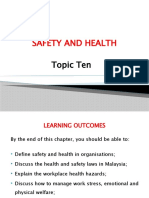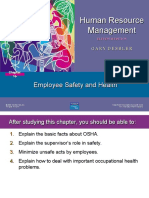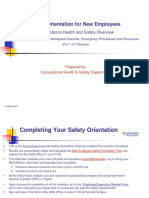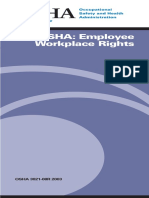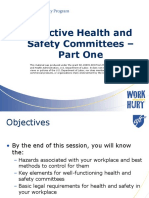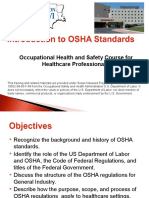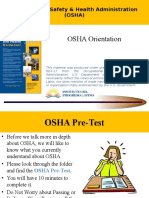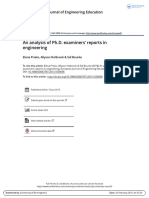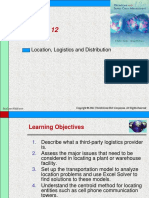Safety and Health: Managing Human Resources
Safety and Health: Managing Human Resources
Uploaded by
anna regarCopyright:
Available Formats
Safety and Health: Managing Human Resources
Safety and Health: Managing Human Resources
Uploaded by
anna regarOriginal Title
Copyright
Available Formats
Share this document
Did you find this document useful?
Is this content inappropriate?
Copyright:
Available Formats
Safety and Health: Managing Human Resources
Safety and Health: Managing Human Resources
Uploaded by
anna regarCopyright:
Available Formats
Safety and Health
Managing Human Resources
Bohlander • Snell 14th edition
© 2007 Thomson/South-Western. PowerPoint Presentation by Charlie Cook
All rights reserved. The University of West Alabama
Objectives
After studying this chapter, you should be able to:
1. Summarize the general provisions of the
Occupational Safety and Health Act (OSHA).
2. Describe what management can do to create a safe
work environment.
3. Identify the measures that should be taken to
control and eliminate health hazards.
4. Describe the organizational services and programs
for building better health.
5. Explain the role of employee assistance programs
in HRM.
6. Indicate methods for coping with stress.
© 2007 Thomson/South-Western. All rights reserved. 12–2
Safety and Health: It’s the Law
In 2002 there were 5.5 million injuries/illnesses among
private-sector firms.
Back problems cost employers $50 billion yearly in
workers’ compensation costs and $50 billion in indirect
costs In 2002, more than 340,000 OSHA calls involved
injuries to the back.
In 2003, there were 609 private-sector work-related
homicides.
In any year, approximately 75 million working days are
lost because of on-the-job injuries.
In 2003, 5,559 employees died from work accidents.
© 2007 Thomson/South-Western. All rights reserved. 12–3
Occupational Safety and Health Act (OSHA)
of 1970
• Mission of OSHA
To assure the safety and health of America’s workers
by setting and enforcing standards
providing training, outreach, and education
establishing partnerships with businesses
encouraging continual improvements in workplace safety
and health
Coverage of employees—all nongovernmental
employers and employees; state and local
government employees
© 2007 Thomson/South-Western. All rights reserved. 12–4
Provisions of OSHA
• OSHA Standards
Apply to general industry, maritime, construction, and
agriculture
Cover the workplace, machinery and equipment,
material, power sources, processing, protective
clothing, first aid, and administrative requirements.
• Enforcement of the Act
The Secretary of Labor is authorized by the Act to
conduct workplace inspections, to issue citations, and
to impose penalties on employers.
Inspections are conducted by the Occupational Safety
and Health Administration of the Department of Labor.
© 2007 Thomson/South-Western. All rights reserved. 12–5
Enforcing OSHA Standards
• Workplace inspections
• Citations and penalties
• On-site consultations
• Voluntary protection programs
• Training and education
© 2007 Thomson/South-Western. All rights reserved. 12–6
OSHA’s System of Inspection Priorities
First
Inspection of imminent danger situations
Level
Investigation of catastrophes, fatalities, and
Second
accidents that result in hospitalization of five or
Level more employees
Investigation of valid employee complaints of
Third
alleged violations of standards or of unsafe or
Level unhealthful working conditions
Special-emphasis inspections aimed at specific
Fourth high-hazard industries, occupations, or
Level substances that are injurious to health
© 2007 Thomson/South-Western. All rights reserved. 12–7
Citations and Penalties
A violation that has a direct relationship to job safety
Other-Than- and health, but one unlikely to cause death or serious
Serious physical harm. OSHA may propose a penalty of up to
$7,000 for each violation.
A violation where there is substantial probability that
death or serious physical harm could result and the
Serious employer knew, or should have known, of the hazard.
OSHA may propose a mandatory penalty of up to
$7,000 for each violation.
A violation that the employer intentionally and
knowingly commits, or a violation that the employer
Willful
commits with plain indifference to the law. OSHA may
propose penalties of up to $70,000 for each violation.
© 2007 Thomson/South-Western. All rights reserved. 12–8
Voluntary Protection Programs (VPPs)
• Programs that encourage employers to go
beyond the minimum requirements of OSHA.
Star, Merit, and Demonstration programs
Purpose of VPPs:
Recognize outstanding achievement of those who have
successfully incorporated comprehensive safety and
health programs into their total management system.
Motivate others to achieve excellent safety and health
results in the same outstanding way.
Establish a relationship among employers, employees,
and OSHA that is based on cooperation rather than
coercion.
© 2007 Thomson/South-Western. All rights reserved. 12–9
Employer Responsibilities under OSHA
• Provide hazard-free workplace. • Warn employees of potential
hazards.
• Be familiar with mandatory
OSHA standards. • Establish operating procedures
to protect employee safety &
• Inform all employees about
health, and communicate them.
OSHA.
• Provide medical examinations
• Examine workplace conditions
where required by OSHA
for conformity to applicable
standards.
standards.
• Provide training required by
• Minimize or reduce hazards.
OSHA standards.
• Provide safe tools and
equipment.
© 2007 Thomson/South-Western. All rights reserved. 12–10
Employer Responsibilities under OSHA
(cont’d)
• Report major accidents and all • Cooperate with OSHA
job-caused deaths to nearest compliance officer for
OSHA office. inspections.
• Keep OSHA-required records • Do not discriminate against
of work-related injuries and employees who properly
illnesses. exercise their rights under the
Act.
• Post OSHA poster.
• Post OSHA citations at or near
• Provide employee access to
the worksite involved.
Log (OSHA Form 300)
• Abate cited violations within the
• Provide employee access to
prescribed period.
employee medical/exposure
records.
© 2007 Thomson/South-Western. All rights reserved. 12–11
Employee Responsibilities under OSHA
• Read the OSHA poster at the • Report any job-related injury or
jobsite. illness to the employer, and
seek treatment promptly.
• Comply with all applicable
OSHA standards. • Cooperate with OSHA
compliance officer on
• Follow all employer safety and
inspections.
health rules and regulations.
• Exercise employee rights under
• Wear or use prescribed
the Act in a responsible
protective equipment at work.
manner.
• Report hazardous conditions to
the supervisor.
© 2007 Thomson/South-Western. All rights reserved. 12–12
Computing the Incidence Rate
• The following equation computes the incidence
rate, where 200,000 equals the base for 100 full-
time workers who work forty hours a week, fifty
weeks a year:
© 2007 Thomson/South-Western. All rights reserved. 12–13
Hazardous Materials Regulation
• Right-to-Know Laws
Laws that require employers to advise employees
about the hazardous chemicals they handle.
• Hazard Communication Standard (HCS)
OSHA-published hazardous chemical regulations
known as the HCS prescribes a system for
communicating data on health risks of handling
certain materials.
• Material Safety Data Sheets (MSDSs)
Documents that contain vital information about
hazardous substances.
© 2007 Thomson/South-Western. All rights reserved. 12–14
Creating a Safe Work Environment
Safety Motivation Safety Awareness
and Knowledge Programs
Elements in Creating a Safe
Work Environment
Accident
Enforcement of
Investigations
Safety Rules
and Records
© 2007 Thomson/South-Western. All rights reserved. 12–15
Creating a Safe Work Environment (cont’d)
• Promoting Safety Awareness
The Key Role of the Supervisor
Communicating the need to work safely.
Proactive Safety Training Program
First aid, defensive driving, accident prevention
techniques, hazardous materials, and emergency
procedures.
Information Technology and Safety Awareness and
Training
© 2007 Thomson/South-Western. All rights reserved. 12–16
Highlights in HRM 3
Organizations Providing Safety Awareness and
Training Materials
National Safety Council
Occupational Safety and Health Administration
American Society of Safety Engineers
American Industrial Hygiene Association
Canadian Society of Safety Engineering
American Conference of Governmental Industrial Hygienists
American Association of Occupational Health Nurses
American College of Occupational and Environmental Medicine
Risk and Insurance Management Society
British Occupational Hygiene Society
Drug & Alcohol Testing Industry Association
Emergency Nurses Association
International Association of Fire Chiefs
National Hearing Conservation Association
Society of Human Resource Management
© 2007 Thomson/South-Western. All rights reserved. 12–17
Creating a Safe Work Environment (cont’d)
• Typical Safety Rules
Using proper safety devices
Using proper work procedures
Following good housekeeping practices
Complying with accident- and injury-reporting
procedures
Wearing required safety clothing and equipment
Avoiding carelessness and horseplay
© 2007 Thomson/South-Western. All rights reserved. 12–18
Enforcing Safety Rules
• Actively encourage employee participation in
the safety program by:
Jointly setting safety standards with management
Participation in safety training
Involvement in designing and implementing special
safety training programs
Involvement in establishing safety incentives and
rewards
Inclusion in accident investigations.
© 2007 Thomson/South-Western. All rights reserved. 12–19
Investigating and Recording Accidents
• Recordable Case
Any occupational death, illness, or injury to be
recorded in the log (OSHA Form 300).
Recordable accidents include: death, days away from
work, restricted work or transfer to another job, or
medical treatment beyond first aid.
Other problems include loss of consciousness or
diagnosis of a significant injury or illness by a
healthcare professional.
© 2007 Thomson/South-Western. All rights reserved. 12–20
Figure 12–1 Guide to Recording Cases under the Occupational Safety and Health
Note: A case must involve a death, or
an illness, or an injury to an employee.
© 2007 Thomson/South-Western. All rights reserved. 12–21
Highlights in HRM 4
Job Safety and
Health Protection
Poster
© 2007 Thomson/South-Western. All rights reserved. 12–22
Health Hazards and Issues
Proliferating Video Display
Chemicals Terminals
Cumulative Trauma
Indoor Air Quality AIDS Disorders
© 2007 Thomson/South-Western. All rights reserved. 12–23
Creating a Healthy Work Environment
• Recognizing and Controlling Health Hazards
Related to Hazardous Materials and Processes
Use substitutes for hazardous materials.
Alter hazardous processes and engineering controls.
Enclose or isolate hazardous processes.
Issue clothing to protect against hazards.
Improve ventilation.
© 2007 Thomson/South-Western. All rights reserved. 12–24
Creating a Healthy Work Environment
(cont’d)
• Problems with Video Display Terminals (VDT)
Visual difficulties, muscular aches and pains, and job
stress
Solutions:
Place the computer screen four to nine inches below eye
level.
Keep the monitor directly in front of you.
Sit in an adjustable-height chair and use a copyholder that
attaches to both the desk and the monitor.
Use a screen with adjustable brightness and contrast
controls.
Use shades or blinds to reduce the computer-screen glare
created by window lighting.
© 2007 Thomson/South-Western. All rights reserved. 12–25
Creating a Healthy Work Environment
(cont’d)
• Cumulative Trauma Disorders (Repetitive Motion
Injuries)
Injuries involving tendons of the fingers, hands, and
arms that become inflamed from repeated stresses
and strains resulting from jobs requiring repetitive
motion of the fingers, hands, or arms.
Injuries lower employee productivity, increase
employer health costs, and incur workers’
compensation payments.
© 2007 Thomson/South-Western. All rights reserved. 12–26
Figure 12–2 Key Elements for a Successful Ergonomics Program
• Provide notice and training for employees.
• Conduct pre-injury hazard assessment.
• Involve employees.
• File injury reports.
• Plan and execute.
• Evaluate and assess the ergonomics program.
© 2007 Thomson/South-Western. All rights reserved. 12–27
Workplace Violence
• Reducing Violence in the Workplace
Commitment to prevent violence
Identify areas of potential violence
Develop violence prevention policies
Provide violence prevention training
Evaluate program effectiveness
© 2007 Thomson/South-Western. All rights reserved. 12–28
Figure 12–3 Violence Indicators: Know the Warning Signs
• Direct or veiled threatening statements
• Recent performance declines, including concentration problems and
excessive excuses
• Prominent mood or behavior changes; despondence
• Preoccupation with guns, knives, or other weapons
• Deliberate destruction of workplace equipment; sabotage
• Fascination with stories of violence
• Reckless or antisocial behavior; evidence of prior assaultive behavior
• Aggressive behavior or intimidating statements
• Written messages of violent intent; exaggerated perceptions of
injustice
• Serious stress in personal life
• Obsessive desire to harm a specific group or person
• Violence against a family member
• Substance abuse
Source: Adapted from Violence in the Workplace: Risk Factors and Prevention Strategies, NIOSH Bulletin #59; Walter
Brennan, “Sounding Off about Verbal Abuse,” Occupational Health 55, no. 11 (November 2003): 22; and Larry J. Chavez,
“Benefits That Can Prevent Workplace Violence,” Employee Benefit Plan Review 58, no. 2 (August 2003): 6.
© 2007 Thomson/South-Western. All rights reserved. 12–29
Terrorism
• To deter terrorist attacks:
Heighten ID checks and baggage screening
Increase video monitoring with threat-recognition
software to back up human surveillance
Install blast-resistant glass to reduce casualties
Have offsite emergency offices
Tighten garage security with stepped-up inspections
Stagger deliveries to reduce truck traffic
Develop emergency evacuation procedures, including
escape routes, emergency equipment, and gathering
locations
© 2007 Thomson/South-Western. All rights reserved. 12–30
Crisis Management Teams
• Teams, composed of both hourly and
managerial employees, conduct:
Initial risk assessment surveys
Develop action plans to respond to violent situations
Perform crisis intervention during violent, or
potentially violent, encounters
© 2007 Thomson/South-Western. All rights reserved. 12–31
Figure 12–4 Calming an Angry Employee
• Strive to save the employee’s dignity during an angry confrontation. Don’t
attack a person’s rash statements or continue a muddled line of thinking.
• Hold all conversations in private. Do not allow the employee to create an
embarrassing public situation for himself or herself, yourself, or other
employees.
• Always remain calm. Anger or aggressiveness on your part will trigger a
similar response in the employee.
• Listen to the employee with an open mind and nonjudgmental behavior. Give
the employee the benefit of hearing him or her out.
• Recognize the employee’s legitimate concerns or feelings. Agree that the
employee has a valid point and that you will work to correct the problem.
• If the employee is very emotional or if the engagement seems out of control,
schedule a delayed meeting so people can calm down.
• Keep the discussion as objective as possible. Focus on the problem at hand,
not the personalities of individuals. A cornerstone of conflict resolution is to
“attack the problem, not the personality.”
• If the employee appears overly aggressive, withdraw immediately and seek
professional help before any further discussion with the employee.
• If your efforts fail to calm the employee, report the incident to your manager,
security, or human resource personnel.
Source: Adapted from professional literature on crisis management and seminars attended by the authors.
© 2007 Thomson/South-Western. All rights reserved. 12–32
Building Better Health
Alternative
Wellness Programs
Approaches
Health Services Focus on Nutrition
© 2007 Thomson/South-Western. All rights reserved. 12–33
Employee Assistance Programs
Alcoholism
Emotional Abuse of Illegal
Problems Drugs
Personal Abuse of
Crises Legal Drugs
© 2007 Thomson/South-Western. All rights reserved. 12–34
Dealing with Troubled Employees
• Monitor:
Employee performance and document unusual
employee behavior
• Advise:
Employee about negative job-performance and
suggest professional counseling assistance
• Make reasonable accommodations:
To employees covered by Federal legislation
• Take disciplinary action when appropriate
• Maintain contact with HR personnel for guidance
and advice
© 2007 Thomson/South-Western. All rights reserved. 12–35
Abuse of Illegal Drugs
• The Drug-Free Workplace Act of
1988
Requires federal contractors and
recipients of federal grants to ensure
a drug-free work environment.
Department of Defense (DOD) and
Department of Transportation (DOT)
specify that employers entering into
contracts with them certify their
intention to maintain a drug-free
workplace.
Required drug testing for specific
positions
© 2007 Thomson/South-Western. All rights reserved. 12–36
What Is Stress?
• Stress
Any adjustive demand caused by physical, mental, or
emotional factors that requires coping behavior.
• Alarm Reaction
A response to stress that involves an elevated heart
rate, increased respiration, elevated levels of
adrenaline in the blood, and increased blood
pressure.
© 2007 Thomson/South-Western. All rights reserved. 12–37
Job-Related Stress
• Eustress
Positive stress that accompanies
achievement and exhilaration.
• Distress
Harmful stress characterized by a
loss of feelings of security and
adequacy.
• Burnout
Most severe stage of distress,
manifesting itself in depression,
frustration, and loss of productivity.
© 2007 Thomson/South-Western. All rights reserved. 12–38
Coping with Stress
• Major Stressors:
Responsibility without authority
Inability to voice complaints
Prejudice because of age, gender, race, or religion
Poor working conditions
Inadequate recognition
Lack of a clear job description or chain of command
Unfriendly interpersonal relationships
© 2007 Thomson/South-Western. All rights reserved. 12–39
Figure 12–5 Tips for Reducing Job-Related Stress
• Build rewarding relationships with co-workers.
• Talk openly with managers or employees about job or personal
concerns.
• Prepare for the future by keeping abreast of likely changes in job
demands.
• Don’t greatly exceed your skills and abilities.
• Set realistic deadlines; negotiate reasonable deadlines with
managers.
• Act now on problems or concerns of importance.
• Designate dedicated work periods during which time interruptions
are avoided.
• When feeling stressed, find time for detachment or relaxation.
• Don’t let trivial items take on importance; handle them quickly or
assign them to others.
• Take short breaks from your work area as a change of pace.
© 2007 Thomson/South-Western. All rights reserved. 12–40
Key Terms
• alarm reaction • eustress
• burnout • Material Safety Data
• cumulative trauma Sheets (MSDSs)
disorders • recordable case
• depression • right-to-know laws
• distress • stress
© 2007 Thomson/South-Western. All rights reserved. 12–41
You might also like
- 30Hr Construction Study GuideDocument105 pages30Hr Construction Study GuideMuhammad Younas100% (12)
- What Is Faith by R.C. SproulDocument69 pagesWhat Is Faith by R.C. SproulERMIAS AmanuelNo ratings yet
- Collectors Investments: South Africa Coin ListDocument5 pagesCollectors Investments: South Africa Coin ListbelebelNo ratings yet
- Introduction To Osha: Directorate of Training and Education OSHA Training InstituteDocument36 pagesIntroduction To Osha: Directorate of Training and Education OSHA Training InstituteVivek ParitNo ratings yet
- Consejos para Prevencion de Accidentes en El TrabajoDocument3 pagesConsejos para Prevencion de Accidentes en El TrabajoSUPER INDUSTRIAL ONLINENo ratings yet
- Osha Standards PDFDocument3 pagesOsha Standards PDFahamedNo ratings yet
- Osha Arquivo 02Document6 pagesOsha Arquivo 02ana paolaNo ratings yet
- Osha HandoutDocument14 pagesOsha Handoutarryan79No ratings yet
- Intro To OSHADocument30 pagesIntro To OSHAPrasanth BharathNo ratings yet
- Osha IntroductionDocument5 pagesOsha Introductionadham adhomaNo ratings yet
- Topic 10 Safety and HealthDocument23 pagesTopic 10 Safety and HealthRodrigo JimenezNo ratings yet
- Introduction To Osha: Directorate of Training and Education OSHA Training InstituteDocument36 pagesIntroduction To Osha: Directorate of Training and Education OSHA Training Institutethakur_neha20_903303No ratings yet
- Intro To Osha PresentationDocument36 pagesIntro To Osha PresentationAnkita routNo ratings yet
- Golden Gate BridgeDocument6 pagesGolden Gate BridgeBashairu WaseemNo ratings yet
- OSHA Master BookDocument99 pagesOSHA Master BookAzad pravesh khanNo ratings yet
- MunicatingDocument3 pagesMunicatingnsivasankar14No ratings yet
- 1-Introduction To OSHADocument8 pages1-Introduction To OSHAosama1928No ratings yet
- Human Resource Management: Safety, Health, and Risk ManagementDocument28 pagesHuman Resource Management: Safety, Health, and Risk ManagementA.s.qudah QudahNo ratings yet
- IIPP-NA-Factsheet M Basics OSHA-1Document6 pagesIIPP-NA-Factsheet M Basics OSHA-1fu.fach14No ratings yet
- Occupational Health and Safety Course For Healthcare ProfessionalsDocument44 pagesOccupational Health and Safety Course For Healthcare ProfessionalsAtef Ragab100% (2)
- Factsheet: Occupational Safety and Health Administration (Osha) InspectionsDocument2 pagesFactsheet: Occupational Safety and Health Administration (Osha) InspectionsMarcus CoresiNo ratings yet
- Factsheet: Occupational Safety and Health Administration (Osha) InspectionsDocument2 pagesFactsheet: Occupational Safety and Health Administration (Osha) InspectionsEngineer MustafaNo ratings yet
- Module 1 Intro To OSHADocument25 pagesModule 1 Intro To OSHAluis5107No ratings yet
- Promoting Safety and HealthDocument17 pagesPromoting Safety and HealthfurqanmrNo ratings yet
- OSHA Handout EnglishDocument267 pagesOSHA Handout Englishmohamed eldalyNo ratings yet
- OSHA 10 Construction - Module 1 - Study GuideDocument9 pagesOSHA 10 Construction - Module 1 - Study GuideJaime GuerreroNo ratings yet
- MESH Module 2Document22 pagesMESH Module 2meimc.hseNo ratings yet
- OshaDocument6 pagesOshalucasNo ratings yet
- Fy11 SH 22300 11 OSHAOrientationDocument31 pagesFy11 SH 22300 11 OSHAOrientationferoz khanNo ratings yet
- Introto OSHADocument47 pagesIntroto OSHAMurtdaNo ratings yet
- Dessler ch16Document50 pagesDessler ch16Jaan MukherjeeNo ratings yet
- Introduction of OSHADocument9 pagesIntroduction of OSHAHAMID RAZANo ratings yet
- Health and Safety in HRDocument49 pagesHealth and Safety in HRArthur AguilarNo ratings yet
- 04 Occupational Health and EnvironmentDocument68 pages04 Occupational Health and EnvironmentUmer QureshiNo ratings yet
- Module 1 - Intro To OSHADocument25 pagesModule 1 - Intro To OSHAMohamed Wahid100% (2)
- Principles of Occupational Safety and Loss ControlDocument34 pagesPrinciples of Occupational Safety and Loss ControlahdabmkNo ratings yet
- 1.0 1.1 Definition of Occupational, Safety and Health AdministrationDocument28 pages1.0 1.1 Definition of Occupational, Safety and Health AdministrationKHAI FUSINo ratings yet
- Occupational Safty and Health Administation EssayDocument5 pagesOccupational Safty and Health Administation Essayapi-282368086No ratings yet
- Osha Poster PDFDocument1 pageOsha Poster PDFMelvin MagbanuaNo ratings yet
- Check ListDocument35 pagesCheck ListAli WaqasNo ratings yet
- OSHADocument29 pagesOSHAGustavo FeisbukeroNo ratings yet
- 1 OshaDocument25 pages1 OshaKamran JUTTNo ratings yet
- OSHA - Employee Workplace RightsDocument25 pagesOSHA - Employee Workplace RightsManuel OrlandoNo ratings yet
- Hs Committees Part1Document30 pagesHs Committees Part1Tan Chi SianNo ratings yet
- Introduction To OSHADocument44 pagesIntroduction To OSHAahdabmkNo ratings yet
- Worker Guide To OhsDocument7 pagesWorker Guide To OhsRamesh SuriyanarayananNo ratings yet
- OSHA 30 ManualDocument440 pagesOSHA 30 ManualNina Bays100% (4)
- Osha 3165Document1 pageOsha 3165Jair Alejandro CANo ratings yet
- Occupational Safety and Health: Lecture NotesDocument26 pagesOccupational Safety and Health: Lecture NotesJonathan TungalNo ratings yet
- OSHA Orientation: Occupational Safety & Health Administration (OSHA)Document31 pagesOSHA Orientation: Occupational Safety & Health Administration (OSHA)raj Kumar100% (1)
- 1 INTRO BOSH AutosavedDocument92 pages1 INTRO BOSH AutosavedMarion DominoNo ratings yet
- OSHA 30 Module 2.2Document1 pageOSHA 30 Module 2.2Kim ArthurNo ratings yet
- CMT212Chapt6Worksheet AADocument3 pagesCMT212Chapt6Worksheet AAdancerabby23No ratings yet
- Occupation Health & Safety Act Skill Trades 1201 Power and EnergyDocument43 pagesOccupation Health & Safety Act Skill Trades 1201 Power and EnergyElmarie J'Anne MicuNo ratings yet
- Module 009 Protecting and Expanding Organizational Reach Workplace Safety Health and SecurityDocument12 pagesModule 009 Protecting and Expanding Organizational Reach Workplace Safety Health and SecurityNoe AgubangNo ratings yet
- Hoja Informativa Sobre Bloqueo y Etiquetado en InglesDocument2 pagesHoja Informativa Sobre Bloqueo y Etiquetado en InglesYisel RomeroNo ratings yet
- Osha 1994 Part 2Document31 pagesOsha 1994 Part 2drfamomaNo ratings yet
- OhsDocument42 pagesOhsapi-242717528No ratings yet
- The Construction Safety Guide: Injury and Illness Prevention through DesignFrom EverandThe Construction Safety Guide: Injury and Illness Prevention through DesignRating: 4 out of 5 stars4/5 (6)
- The Real Product Safety Guide: Reducing the Risk of Product Safety Alerts and RecallsFrom EverandThe Real Product Safety Guide: Reducing the Risk of Product Safety Alerts and RecallsNo ratings yet
- Occupational Stress of Nurses in South Africa: Research ArticleDocument12 pagesOccupational Stress of Nurses in South Africa: Research Articleanna regarNo ratings yet
- Translate JurnalDocument5 pagesTranslate Jurnalanna regarNo ratings yet
- Stress: Concepts, Theoretical Models and Nursing InterventionsDocument6 pagesStress: Concepts, Theoretical Models and Nursing Interventionsanna regarNo ratings yet
- An Analysis of Ph.D. Examiners' Reports in EngineeringDocument13 pagesAn Analysis of Ph.D. Examiners' Reports in Engineeringanna regarNo ratings yet
- Location, Logistics and Distribution: Mcgraw-Hill/IrwinDocument12 pagesLocation, Logistics and Distribution: Mcgraw-Hill/Irwinanna regarNo ratings yet
- The Challenge of Human Resources ManagementDocument35 pagesThe Challenge of Human Resources Managementanna regarNo ratings yet
- Nursing The Unconscious PatientDocument11 pagesNursing The Unconscious Patientanna regar100% (1)
- Imogene King HandoutDocument21 pagesImogene King Handoutanna regarNo ratings yet
- The Nature of Strategic ManagementDocument44 pagesThe Nature of Strategic Managementanna regarNo ratings yet
- Chap 009Document15 pagesChap 009anna regarNo ratings yet
- Demand Management and Forecasting: Mcgraw-Hill/IrwinDocument15 pagesDemand Management and Forecasting: Mcgraw-Hill/Irwinanna regarNo ratings yet
- Resume GCDocument2 pagesResume GCapi-356177406No ratings yet
- Voice of Farmers in Uttar Pradesh - Rashtriya Kisan ManchDocument8 pagesVoice of Farmers in Uttar Pradesh - Rashtriya Kisan ManchRashtriya Kisan ManchNo ratings yet
- Manifiesto de La Biblioteca Pública de La IFLA/UNESCO 2022: Una Herramienta Poderosa para La Defensa de Las BibliotecasDocument4 pagesManifiesto de La Biblioteca Pública de La IFLA/UNESCO 2022: Una Herramienta Poderosa para La Defensa de Las BibliotecasR͒o͒s͒a͒ Facio AstocondorNo ratings yet
- Sr. No Name JOINING DATE (Dd/mm/yy)Document5 pagesSr. No Name JOINING DATE (Dd/mm/yy)Babar MairajNo ratings yet
- Lecture Notes Quanti 1Document105 pagesLecture Notes Quanti 1Godfred AbleduNo ratings yet
- Citizen Journalism WorkshopDocument2 pagesCitizen Journalism WorkshopNezam MarandaNo ratings yet
- Sas #10 - Edu 537 PDFDocument7 pagesSas #10 - Edu 537 PDFDivine Joy Atractivo PinedaNo ratings yet
- Rhythmic Counting SyllablesDocument2 pagesRhythmic Counting SyllablesBlessed UuganaaNo ratings yet
- A Study in Executive-Judicial Conflict - The Indian CaseDocument22 pagesA Study in Executive-Judicial Conflict - The Indian Casesanikasunil1552No ratings yet
- Controls, Start-Up, Operation, Service and Troubleshooting: Aquaforce 30Xw150-400 Water-Cooled Liquid ChillersDocument172 pagesControls, Start-Up, Operation, Service and Troubleshooting: Aquaforce 30Xw150-400 Water-Cooled Liquid ChillersWagner MoraisNo ratings yet
- Liveability in Social Housing: Three Case-Studies in FlandersDocument24 pagesLiveability in Social Housing: Three Case-Studies in FlandersMustafa OmarNo ratings yet
- 2023 Daniel T Warren V Gary A Dickson Et Al - Responding PapersDocument29 pages2023 Daniel T Warren V Gary A Dickson Et Al - Responding PapersDaniel T. WarrenNo ratings yet
- Telemedicine Through The Internet and IntranetDocument14 pagesTelemedicine Through The Internet and Intranetalexhuq2010100% (1)
- Learning Plan: Analogy To Show Relationships of WordsDocument2 pagesLearning Plan: Analogy To Show Relationships of WordsMonaliza PawilanNo ratings yet
- Lindt Phases 1 and 2Document30 pagesLindt Phases 1 and 2api-24727320550% (2)
- Invoice Creation On GeMDocument9 pagesInvoice Creation On GeMhisab bNo ratings yet
- Neuroretinitis: PathologyDocument3 pagesNeuroretinitis: PathologyImanOldSTudenTNo ratings yet
- Present Simple WorkshopDocument2 pagesPresent Simple WorkshopnataliaNo ratings yet
- Mongols Mini DBQDocument4 pagesMongols Mini DBQasdasiodasodNo ratings yet
- DLP in Vocal and Intrumental MusicDocument6 pagesDLP in Vocal and Intrumental MusicRyan TimogNo ratings yet
- NotesDocument5 pagesNotesKorrine FloresNo ratings yet
- Biology Paper Two (CSEC)Document14 pagesBiology Paper Two (CSEC)Mario PalmerNo ratings yet
- 119.8 MB 117.6 MB in File List Total Lsize 163 150 13 21 1 7 Rascoe Badguy Wes Mantooth 6/20/2007-6/21/2007 Formhistory - DatDocument4 pages119.8 MB 117.6 MB in File List Total Lsize 163 150 13 21 1 7 Rascoe Badguy Wes Mantooth 6/20/2007-6/21/2007 Formhistory - DatSabrina JohnsonNo ratings yet
- Calendar Diary 2023 Order Form With CalculationDocument2 pagesCalendar Diary 2023 Order Form With CalculationMadhu Electricals & EngineeringNo ratings yet
- GUNUNG AGUNG A BaturDocument2 pagesGUNUNG AGUNG A BaturnikpokorNo ratings yet
- Bertrand Russell - What I Have Lived ForDocument2 pagesBertrand Russell - What I Have Lived Formetalover36100% (1)
- ConstractivismDocument30 pagesConstractivismRaiyan SyedNo ratings yet
- Sample Question Paper: General Knowledge and Current AffairsDocument4 pagesSample Question Paper: General Knowledge and Current Affairsshano chaudharyNo ratings yet










